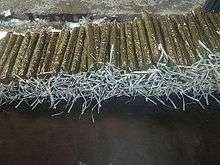Naswar
Naswār (Pashto: نسوار; Cyrillic script: насва́р), also called nās (ناس; на́с), nāts (ناڅ; на́ц), or nasvay (نسوای; насвай), is a moist, powdered tobacco snuff consumed mostly in Afghanistan, Pakistan, India, Iran, Kazakhstan, Kyrgyzstan, Russia, Tajikistan, Turkmenistan, and Uzbekistan. Naswar is stuffed in the floor of the mouth under the lower lip, or inside the cheek, for extended periods of time. It is similar to dipping tobacco and snus.

History
Naswar was introduced into Western Europe by a Spanish monk named Ramon Pane after Columbus' second voyage to the Americas during 1493-1496.[1] In 1561, Jean Nicot, the French ambassador in Lisbon, Portugal, sent naswar to Catherine de' Medici to treat her son's persistent migraines.[2]
Use in Afghanistan, Pakistan, and Central Asia
The green powder form is used most frequently. It is made by pouring water into a cement-line cavity, to which Lime (calcium hydroxide) or juniper is added as flavorings, and then air-cured, sun-dried, powdered tobacco is added. Indigo is added to the mixture to impart color.
Currently, the countries of the region freely sell naswar in the markets, usually on trays with cigarettes and sunflower seeds. The only exception is Turkmenistan, where in 2008 President Gurbanguly Berdimuhamedow signed a decree banning the production, sale, use, and import of naswar.[3]
In 2011 naswar was included in the list of narcotic and psychoactive substances to be controlled in Kazakhstan.[4]
Use in Russia and Europe
On the territory of Russia, naswar is not a traditional product, but it gained popularity in recent years especially among teenagers.
Naswar is sold in the markets of Moscow[5] and in other cities of the Urals, Volga, and other regions of the country. Its trade is usually conducted on trays with spices, with naswar being bought as a means of nicotine addiction.
According to the association of tobacco distributors "Grandtabak", in the first half of 2004, Russia's import of naswar or "chewing tobacco" amounted to almost 67 tons (total value of 16,500 US dollars), primarily from Kazakhstan, Kyrgyzstan, and Tajikistan.[6]
On 23 February 2013, the Russian State Duma signed a federal law (N 15-ФЗ) which banned both wholesale and retail naswar from 1 June 2013 onward (Part 8 of Article 19 of the Law) in Russia.[7]
There are reports on physicians instructing their patients to use naswar in Belarus.[8] In Estonia, naswar is being distributed to discothèques.[9]
Characteristics
There are two forms of naswar; powder, and a paste cake style mixed with lime. A very pungent and powerful smell, yet a subtle flavor as it mixes with the saliva. The nicotine effect can occur within 5 minutes after intake producing a slight burn to the inner lip and tongue.
Naswar has a very distinct smell resembling that of a fresh bale of coastal hay.
Cost
Readily available in most Afghan tobacco shops, the average cost for a small 15 gram package is 10 afs (December 2013 exchange rate: 10.00 AFN ).
Manufacture
Sun and heat-dried tobacco leaves, slaked lime, ash from tree bark, and flavoring and coloring agents are mixed together. Water is added and the mixture is rolled into balls.
Nas: tobacco, ash, cotton or sesame oil,[10] water, and sometimes gum.
Naswar: tobacco, slaked lime, indigo, cardamom, oil, menthol, water.
Controversy
In November 2006 an editorial in the newspaper Daily Times in Pakistan caused some controversy over its allegedly biased representations of Pashtun predilection for naswar.[11]
Side effects
The major side effect of using naswar is addiction, and it becomes difficult to get rid of it. As the lime is added, it is also increasingly known that naswar often causes oral and throat cancer.[12]
See also
References
- ↑ Bourne, G. E.: Columbus, Ramon Pane, and the Beginnings of American Anthropology (1906), Kessinger Publishing, 2003, page 5
- ↑ McKenna, T.: Food of the Gods - The Search for the Original Tree of Knowledge - A Radical History of Plants, Drugs, and Human Evolution, Bantam Books, 1993, page 199
- ↑ "В Туркмении запретили производить, продавать и жевать насвай - ЦентрАзия". Retrieved 30 May 2015.
- ↑ "ИА КазахЗерно". Retrieved 30 May 2015.
- ↑ "Унесённые пленом : Попавшие в плен военнослужащие считаются пропавшими без вести - FLB.ru - Агентство Федеральных Расследований". Retrieved 30 May 2015.
- ↑ Гранд Табак. "Насвай - Словарь терминов - glossary - Гранд Табак". Retrieved 30 May 2015.
- ↑ "Автоматизированная система обеспечения законодательной деятельности". Retrieved 30 May 2015.
- ↑ Medvestnik / Газета «Медицинский вестник»
- ↑ "Газета "Молодежь Эстонии" 10.09.99 Кухня наркоманов становится богаче Инесса КОЛЛОМ.". Retrieved 30 May 2015.
- ↑ US Department of Health and Human Services. Health consequences of using smokeless tobacco: a report of the Advisory Committee to the Surgeon General. Bethesda, Maryland: US Department of Health and Human Services, Public Health Service, 1986.
- ↑ http://www.dailytimes.com.pk/default.asp?page=2006%5C11%5C15%5Cstory_15-11-2006_pg3_1[]
- ↑ Saleem, Saima; Azhar, Abid; Hameed, Abdul; Khan, Mansoor Ahmed; Abbasi, Zubair Ahmed; Qureshi, Navid Rashid; Ajmal, Muhammad (2013). "P53 (Pro72Arg) polymorphism associated with the risk of oral squamous cell carcinoma in gutka, niswar and manpuri addicted patients of Pakistan". Oral Oncology. 49 (8): 818. doi:10.1016/j.oraloncology.2013.04.004. PMID 23683469.